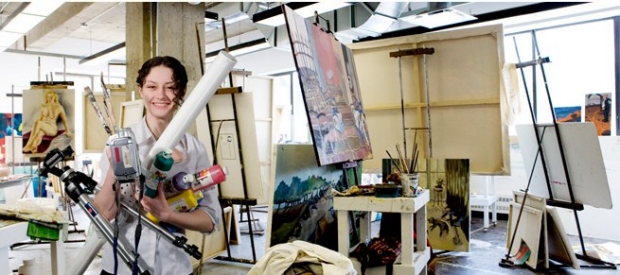Where inspiration meets investigation
 How artists research their ideas is the subject of a colloquium at Concordia February 18 to 20. | Photo by Concordia university
How artists research their ideas is the subject of a colloquium at Concordia February 18 to 20. | Photo by Concordia university
Anyone who has ever spent hours online clicking through link after link knows how easy it is to begin with a question about hanging wallpaper and end up fascinated by a virtual tour of Versailles. That erratic, tangential journey can inspire.
Articulating the creative, non-linear process that characterizes what librarians call artists’ ‘information-seeking behaviours’ has framed visiting research fellow Rebecca Duclos’s “Compulsive Browse” project for the last year. Her research is supported by Concordia’s Gail and Stephen A. Jarislowsky Institute for Studies in Canadian Art.
From February 18 to 20, the research methodology of creative inspiration will be the theme of a small colloquium at Concordia. “It’s going to be a kind of intellectual spa weekend,” laughs Duclos of the event that has attracted enthusiastic interest from arts practitioners, educators, curators, librarians and archivists.
The event begins on February 18 with a “Bibliodérive.” The day-long event, organised in conjunction with Concorrdia’s libraries, will allow registrants to mimic in physical space the virtual meandering so common on the internet. Duclos and Bibliodérive coordinator Zoë Chan are inviting participants to visit a dozen archives, libraries and collections across Montreal ranging from those on the Concordia, Université du Québec à Montréal and McGill campuses to the material at the Musée d’art contemporain, Artexte Information Centre, the Canadian Centre for Architecture and The Word bookstore.
“The librarians, archivists and bookstore owners that we approached all loved the idea of making their collections available to participants for browsing,” said Concordia’s University Librarian, Gerald Beasley. “Everyone has permission to research without a goal. The idea is: Don’t seek, just find,” says Duclos.
Duclos began to think about the ways that investigatory practice informs studio practice while serving as graduate director of an MFA program at the Maine College of Art. She was struck by how art school curricula often place “art history theory over here, and studio practice over there.” She thus developed the idea of “trying to understand the ways artists articulate their individual research approaches without overlaying my academic language.”
Duclos has been interviewing contemporary Canadian artists about their ‘information-seeking behaviours’ and their ‘compulsive browsing’ (another phrase used in the library science literature). Her in-depth interviews with artists across a range of disciplines encourage them to articulate the ways they discover and develop material for their work and most especially how they “describe and legitimate inference, intuition, synchronicity, chance and insight,” as forces that reframe, redirect or enhance their projects. “It often takes a full hour of interviewing just to start to get the language,” she says of the complicated task she has set for herself and her interview subjects.
“There are moments in a project when what artists least expect to appear arrives in their purview, and these discoveries change the discussion entirely – not unlike any kind of research, new stimuli lead them down the rabbit hole,” says Duclos of her interviewees, who run the gamut of ages, levels of formal training and experience. “In textual explications, the dynamic of these iterative moments is often smoothed over.” Duclos is using her research fellowship, the colloquium, and a related graduate-level course she is currently teaching through the Studio Arts program to dig beneath that smoothed surface.
Duclos settled on the title Compulsive Browse to describe this meandering process for the course and the colloquium, “compulsive because it suggests rigour, constancy and passion, and browse because of its tactility, the way you might move through a library or a flea market,” she explains.
After the Bibliodérive, colloquium participants will meet nine Canadian artists who have agreed to speak about their practice. “The artists are going to spend the whole weekend presenting a single project to the group. The idea is to move vertically through each project instead of going wide,” says Duclos. Inviting curators, librarians and educators to the discussion allows them “to understand how artists compulsively browse,” and potentially develop better ways to support their particular types of research.
On the evening of February 19, Martha Wilson, a feminist artist whose show will close that day at the Leonard & Bina Ellen Art Gallery, will give a public lecture. The rest of the colloquium’s activities will take place at the Faculty of Fine Arts (FOFA) Gallery. Gallery directors jake moore and Michèle Thériault “have been fantastic. They seized the opportunity to conjoin our mutual interests in supporting artists and supporting the people who support artists. It’s a great way for Concordia to host other institutional galleries and archives. We are grateful to these practitioners for sharing the ‘behind the scenes’ development of work so that we can all be part of this discussion.”
Also on hand, as presenters and participants, will be several of the students taking Duclos’s seminar. They have been thinking about how to articulate their own practice and interviewing each other to develop a vocabulary for the process. The colloquium will allow them to take their reflection further, while offering an opportunity for professional development.
Related links:
• Compulsive Browse
• Gail and Stephen A. Jarislowsky Institute for Studies in Canadian Art
• Concordia FOFA Gallery
• Concordia Leonard and Bina Ellen Art Gallery
• Concordia Libraries